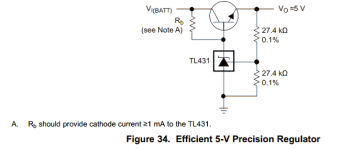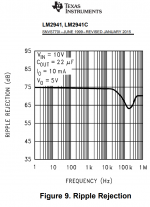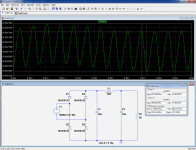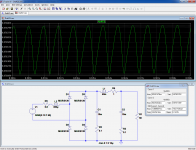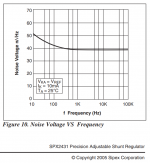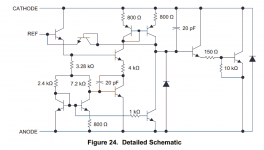Hmmm, the power transformer's secondary provides 9V AC. This feeds a full bridge rectifier, followed by CLC filter: 10,000uF + 40mH + 10,000uF. Finally the voltage regulator circuit gives a regulated 6.0V DC output.
Input to the bridge is 9V RMS which is 12.7V peak. After two diode drops in the bridge, 11.2V peak. Making a pessimistic overestimation of the load current (200mA), ripple at the output of the CLC filter is 0.2V. Namely, a triangle wave that ripples between 11.0V and 11.2V at 120Hz (USA) or 100Hz (EUR).
If you insist upon, let's just say, 0.1 microvolts of ripple at the output of the voltage regulator, then its attenuation at 120 Hz needs to be 1E-7/2E-1 = 5E-7 = -126 dB. That's going to be impossible without negative feedback, and damned difficult with NFB. I suggest using a cascade of two low dropout voltage regulator ICs, since they have -75 dB of attenuation at 120 Hz (figure attached). Then a capacitance multiplier (post #1 without the zener) with extremely heavy filtering of the base node, to reduce noise as low as possible. You are making a trade-off, whether you realize it or not: lower noise (cap multiplier) in exchange for higher output impedance (open loop emitter follower). Since you have not mentioned output impedance even once, I conclude it isn't very important to you.
If you wish to select transistors with extremely high Early voltage for your capacitance multiplier, let me suggest these possible candidates. Yes the PNPs are worse than the NPNs; that is the world we live in:
_
Input to the bridge is 9V RMS which is 12.7V peak. After two diode drops in the bridge, 11.2V peak. Making a pessimistic overestimation of the load current (200mA), ripple at the output of the CLC filter is 0.2V. Namely, a triangle wave that ripples between 11.0V and 11.2V at 120Hz (USA) or 100Hz (EUR).
If you insist upon, let's just say, 0.1 microvolts of ripple at the output of the voltage regulator, then its attenuation at 120 Hz needs to be 1E-7/2E-1 = 5E-7 = -126 dB. That's going to be impossible without negative feedback, and damned difficult with NFB. I suggest using a cascade of two low dropout voltage regulator ICs, since they have -75 dB of attenuation at 120 Hz (figure attached). Then a capacitance multiplier (post #1 without the zener) with extremely heavy filtering of the base node, to reduce noise as low as possible. You are making a trade-off, whether you realize it or not: lower noise (cap multiplier) in exchange for higher output impedance (open loop emitter follower). Since you have not mentioned output impedance even once, I conclude it isn't very important to you.
If you wish to select transistors with extremely high Early voltage for your capacitance multiplier, let me suggest these possible candidates. Yes the PNPs are worse than the NPNs; that is the world we live in:
- small NPN: ZTX696B Measured Beta=520 Measured Vearly=400V
- large NPN: MJE340 Measured Beta=100 Measured Vearly=1600V
- small PNP: ZTX957 Measured Beta=180 Measured Vearly=270V
- large PNP: MJE350 Measured Beta=170 Measured Vearly=330V
_
Attachments
This estimation looks very overpessimistic:Making a pessimistic overestimation of the load current (200mA), ripple at the output of the CLC filter is 0.2V.
With >200mA output current, the ripple looks more like 500µV pp at the output of the filter, or 180µV rms, which relieves the budget of ~56dB
Attachments
Interesting EVA. Do you know the. Noise measurements? Also please explain the part if possible with a schematic -two positive section with floating input circuit and series output.
Noise is not worse than a zener, TI datsheet shows 120nV/sqrt(Hz). The reduced part count will take some engineering, no one else can do this for you, or just pay the penalty of high part count.
Some real parameters will indeed degrade the situation, and other will improve it.Rprimary > 0
Rsecondary > 0
Rfuse > 0
ESR > 0
Inductor_Rseries > 0
Basically, it doesn't change the magnitude order:
Attachments
The raw TL431 will probably have a lower noise than a raw zener, but here, the zener is heavily filtered, which matters a lot.Noise is not worse than a zener, TI datsheet shows 120nV/sqrt(Hz). The reduced part count will take some engineering, no one else can do this for you, or just pay the penalty of high part count.
If you want to do the same with the 431, you cannot use it anymore in a GNFB context (at least without severe restrictions)
Sipex makes an extremely low-noise version of the TL431 that is pin compatible with the TI device. Even so, with the bandwidth you're likely to get from your voltage regulator, the noise of a GNFB circuit like post#41 will be 100X to 1000X higher than a super heavily filtered zener used as a VREF element.
_
_
Attachments
Out put impedence is more important for devices with high current draw, right? If there is say 100ma output available and device draws only 20-30ma it becomes less relevant, that is my understanding. Please correct me if this is wrong.
Mark is my interpretation correct
Impedance is relative, and 1 ohm for a 100mA supply may seem low enough, but would be hopelessly high for 10A.
Because of this scaling, absolute figures don't mean a lot.
The percentage of regulation vs. loading is much more informative.
I addition, certain types of circuit require an extremely stable supply, because of stability issues, accuracy, and to avoid parasitic signal paths through the rails modulation.
Because of this scaling, absolute figures don't mean a lot.
The percentage of regulation vs. loading is much more informative.
I addition, certain types of circuit require an extremely stable supply, because of stability issues, accuracy, and to avoid parasitic signal paths through the rails modulation.
Sipex makes an extremely low-noise version of the TL431 that is pin compatible with the TI device. Even so, with the bandwidth you're likely to get from your voltage regulator, the noise of a GNFB circuit like post#41 will be 100X to 1000X higher than a super heavily filtered zener used as a VREF element.
_
I interpret the "100X to 1000X" comment as disrespect to equipment and integrated circuit designers, and as disrespect to all experts in control loop physiscs. Noise does not multiply just because someone wants.
TL431 internal schematic is attached. Emitter follower, voltage reference, current source, current mirror, darlington. All emitters have gentle degenration resistors. It works as a low power op-amp with about 120nV/sqrt(Hz) noise. Such a level of noise in a supply rail for another IC amplifier has a negligible contribution to output, as even >20dB PSRR will make supply rail noise contribution to output noise similar to the noise contribution of the own chipamp. Furthermore, the output of a TL431 can be filtered exactly like a zener to reduce noise, if ever needed.
Attachments
In 14 years I have seen this forum shine at some times. Now there is a lot of shame. This text file is rescued from the forum shining times, it compares noise of zeners, LEDs, TL431 and other elements. BZX55-C6V8 zener at high bias is a few times noisier than TL431 with gain for 6V output. I hope no one here has seen reverse biased diode noise in oscilloscope, it's really dirty.
I've made noise generators just amplifying noise of a reverse biased junction.
I've made noise generators just amplifying noise of a reverse biased junction.
Attachments
The measurements in text file are limited to audio band. The noise in the zener has higher bandwidth than TL431, >=10Mhz. Emitter followers can become unstable if not enough b or e series resistance is used, this R also acts as noise bandwidth limiting, but with TL431 it does not increase output resistance significatively. Emitter followers are global negative feedback, as the return path of the control current goes through the load.
- Status
- This old topic is closed. If you want to reopen this topic, contact a moderator using the "Report Post" button.
- Home
- Amplifiers
- Power Supplies
- Zener+Voltage follower
